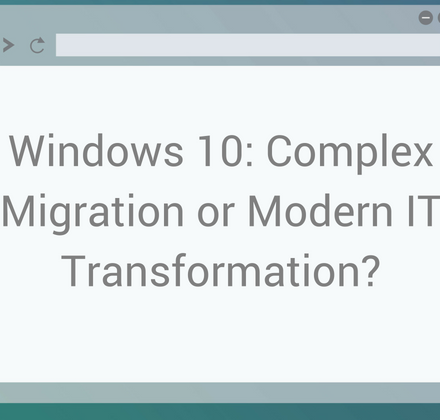If your organization still hasn’t fully migrated to Windows 10, you’re not alone. But with less than two years before extended support for Windows 7 ends, it’s time for businesses to kick their efforts into high gear.
I know what you’re thinking – easier said than done, right? Trying to understand what is required, when it needs to happen and what it means for your users is enough to make your head spin. And when you start considering the time and resources needed to make the move, you’d rather bury that spinning head in the sand.
 One of the things I really enjoy about my job is interaction with customers. I genuinely like hearing about the challenges, frustrations and opportunities facing IT managers today. I’ve heard a lot of comments like “my environment is stable, why do I need the disruption of moving to Windows 10?”
One of the things I really enjoy about my job is interaction with customers. I genuinely like hearing about the challenges, frustrations and opportunities facing IT managers today. I’ve heard a lot of comments like “my environment is stable, why do I need the disruption of moving to Windows 10?”
Luckily, migrating to Windows 10 doesn’t have to be a complicated, headache-inducing challenge. In fact, with a little background information, a plan to move forward and the right partner on your journey, migrating to Windows 10 is an opportunity to modernize IT management for your organization.
And don’t just take my word for it. Our organization is one that has taken the leap and now all-in with Windows 10. We successfully migrated 100% of Dell’s workforce in 2017 – that’s approximately 150,000 upgraded PCs. And we’ve helped countless others make the transition as well.
Read on, because you’re next!
Meeting the Needs of the Evolving Workforce
According to Microsoft, 22 million commercial users have already migrated to Windows 101 and are realizing the benefits of the improved operating system – its deep integration of cloud services, universal app capabilities and enhanced security tools – and a new Windows as a Service model that delivers updates in smaller packages more frequently. (This could be your last large-scale rollout ever!)
Simply put, IT environments based on Windows 10 are more agile, more mobile, more effective and more secure. This is essential to meet the needs of a growing workforce who want easy, on-demand, collaborative experiences and the flexibility to work anywhere, anytime.

Best of Both Worlds with Hybrid Deployment
If Windows 10 is going to help modernize your IT environment and ultimately, how your users get things done – shouldn’t the deployment model transform as well? The ability to easily deploy and manage systems via cloud technology is a major perk of Windows 10 (PCs are essentially turned into thin clients for remote, over-the-air provisioning with solutions like VMware’s Workspace ONE or Microsoft’s AutoPilot).
However, the success of this model depends on the quality and speed of users’ connections, the size of the image and the number of locally installed applications which can significantly hamper the “out-of-the-box” experience. Although we believe this cloud-based model is the future of deployment, the reality is that most IT environments will require a hybrid approach in the near term to accommodate existing IT infrastructures and processes. Hybrid deployment offers the best of both worlds – the speed, control and reliability of factory configuration/installation with the scalability and cost-efficiencies of ongoing management via the cloud.
The Way Forward
So you know Windows 10 is coming, you know it’s important, and you know the benefits it will bring, but you still have concerns. How will you efficiently roll out this new OS, and what if users require new hardware to take full advantage of the features? Can you easily deploy new PCs at the same time?
We’ve been spending the last couple years helping customers through the various stages of their migrations with services designed to make the journey easier:
- Client Deployment Assessment – We assess your current IT practices, make recommendations and help develop an actionable plan for adopting Windows 10.
- ProDeploy Client Suite – Once the plan is in place, you can reduce deployment time for new client systems up to 35 percent2 with Dell experts who will manage configuration and installation.
- PC as a Service – We combine hardware, software, PC lifecycle services and financing into one all-encompassing solution that provides you with a single price per seat per month.
Summary: The Time Is Now
Change is coming and we are here to help. I look forward to continuing my conversations with IT managers and hearing how things are progressing as they make this shift. With the right plan and the right partner, January 14th, 2020 is not just the deadline for migrating to Windows 10, it’s also the beginning of your transformation towards modern IT management.
Sources
1 Windows 10 Embracing Silicon Innovation
2 May 2016 Principled Technologies Report commissioned by Dell. Testing results extrapolated from a 10-system deployment to project time savings for larger deployment compared to in-house manual deployment. Actual results will vary.


